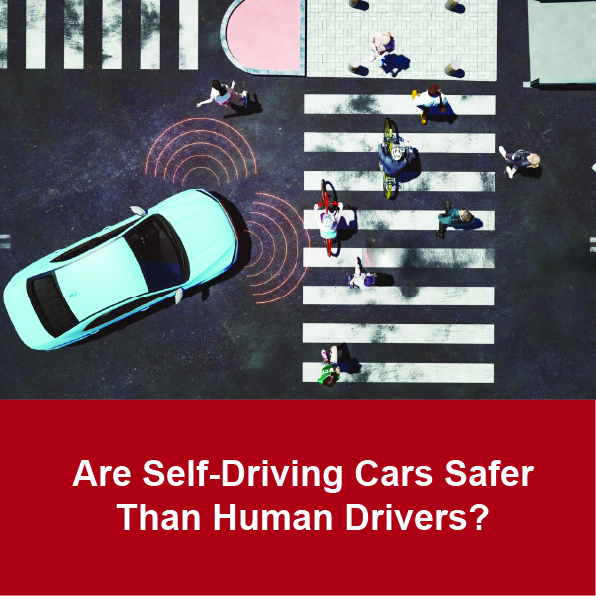
Are Self-Driving Cars Safer Than Human Drivers?
The Debate on Self-Driving Cars: Are They Safer Than Human Drivers?
The conversation around self-driving cars is shifting from science fiction to daily reality. As the technology matures, so does the discussion: Are autonomous vehicles actually safer than human drivers?
At SharpDrive, our focus has always been on driver safety, awareness, and behaviour—because these are the factors we can control. As automated technology becomes more common on our roads, we can’t ignore the role it might play in shaping transport safety for the next generation.
Let’s take a clear-eyed look at the evidence, the risks, and what this means for your fleet, your drivers, and your duty of care.
What Do We Mean By ‘Self-Driving’?
Not all self-driving cars are created equal. The Society of Automotive Engineers (SAE) defines six levels of automation, from Level 0 (no automation) all the way to Level 5 (full automation in all conditions). Most vehicles on the road now sit at Level 2—partial automation, with the driver still responsible.
When we ask if self-driving cars are safer, we need to ask: Which level of automation are we talking about? Under what conditions?
The Promise: Fewer Accidents Caused by Human Error
According to data from the World Health Organization, over 90% of traffic crashes worldwide are caused by human error—things like distraction, fatigue, speeding, or impairment.
Autonomous technology doesn’t get tired. It doesn’t text at the wheel. It reacts instantly to changing conditions, and it doesn’t get impatient on the way home.
In theory, automation could reduce that 90% figure dramatically. And early data supports this:
- A 2020 study by the Insurance Institute for Highway Safety (IIHS) found that autonomous vehicles could prevent around one-third of crashes if all they did was eliminate human perception errors (like failing to detect hazards or reacting too late).
- However, it also found that some crashes—like those involving planning and decision-making—might be harder for AVs to avoid unless systems are designed to prioritise safe decision-making over speed or convenience.
The Reality: Technology Still Has Limits
Despite the promise, self-driving technology isn’t foolproof, and it’s not always safer. A recent report by the National Highway Traffic Safety Administration (NHTSA) in the US showed that while some autonomous vehicles operate without incident, many still struggle in real-world conditions—particularly in edge-case scenarios like poor weather, unpredictable pedestrian behaviour, or temporary roadworks.
There have been well-publicised crashes involving semi-autonomous systems where over-reliance or misunderstanding of the tech contributed to the incident.
So, what does that mean for safety professionals?
Human Drivers Are Still Critical
For now, the safest drivers are humans with the right training, mindset, and tools. Technology can support that—but it can’t replace it entirely.
This is where we come in. At SharpDrive, our driver safety training helps people make smarter decisions behind the wheel. We focus on practical risk management, awareness of road hazards, and real-world scenario-based learning that prepares drivers for what they’ll actually face—not just what the manual says.
Explore our full range of driver safety programmes.
The Middle Ground: Human + Machine Working Together
The real future of safe driving might not be a battle between human and machine—it might be a partnership. At their best, driver-assist technologies (like emergency braking, lane-keeping assistance, and blind spot monitoring) can enhance human performance.
But only if we treat them as support tools, not set-and-forget autopilots.
No matter how smart the tech is, investing in driver education will always be essential. When drivers understand how these systems work—and what they don’t do—they use them more effectively and more safely.
At SharpDrive, we help fleets and organisations embed this knowledge day-to-day. From light vehicles to heavy vehicles, from new starts to experienced operators, we’re here to support a safer driving culture—now and into the future.
Are Self-Driving Cars Safer?
The short answer: It depends.
- Yes, if we’re comparing automation to impaired, distracted, or reckless drivers.
- No, if we’re assuming the tech can handle every situation on its own.
- Yes, when used to support safe human behaviour—not replace it.
Technology can assist. But safety is still a people-first responsibility. When we give drivers the tools, the training, and the support they need, that’s when real change happens.
We’re Here to Help Build That Change
If you're navigating this space—managing a fleet, updating your risk policies, or just trying to stay ahead—let’s talk.
We offer tailored driver safety training built around your needs, your people, and your challenges. And we’ll keep you updated on the road ahead—even as it evolves.
Visit sharpdrive.co to learn more.
Let’s build a safer tomorrow, together.




